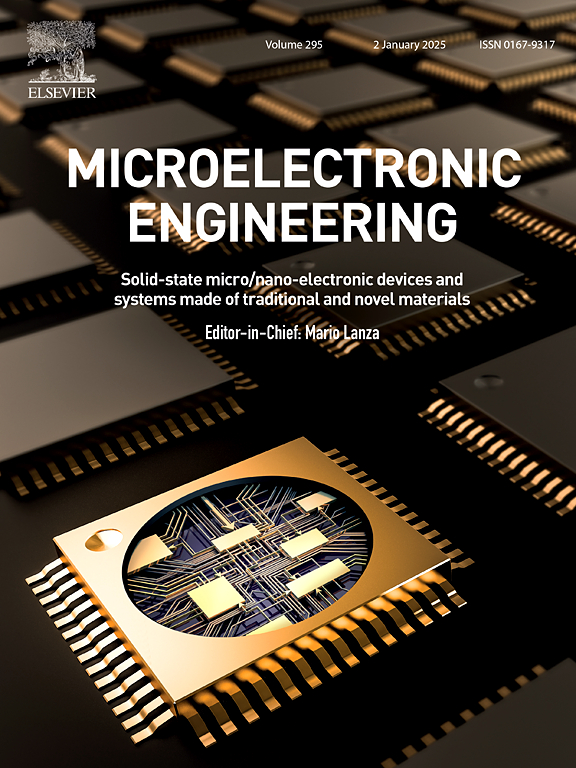Optimization of pattern quality in DMD scanning maskless lithography: A parametric study of the OS3L exposure algorithm
IF 3.1
4区 工程技术
Q2 ENGINEERING, ELECTRICAL & ELECTRONIC
引用次数: 0
Abstract
In digital micromirror device (DMD) scanning maskless lithography systems, the pattern accuracy has a critical effect on the final component quality. However, the patterning performance is highly sensitive to the parameters used in the scanning process. Accordingly, this study examines the effects of three key parameters (the rotation angle of the DMD array, the step size, and the optical distortion of the image projection lens) on the patterning quality of a DMD-based scanning maskless lithography system utilizing an oblique scanning and step-strobe lighting (OS3L) exposure algorithm. The MATLAB simulation results show that the optical distortion of the image projection lens causes an uneven distribution of the exposure points along the x-axis direction, with sparser focal spots on the sides of the exposure field and denser spots in the center. In addition, the results suggest that the DMD rotation angle should be close to (but not less than) the critical angle, i.e., the angle at which the maximum horizontal resolution is obtained. Finally, the light spot distribution is extremely sensitive to the step size, but the relationship between them is unpredictable and nonlinear. Consequently, the effects of the step size on the light spot distribution should be checked on a case-by-case basis. Overall, the results presented in this study provide useful guidelines for the selection of the parameter settings that optimize the patterning quality in DMD-based scanning maskless lithography systems using the OS3L exposure algorithm.
DMD扫描无掩模光刻中图案质量的优化:OS3L曝光算法的参数化研究
在数字微镜器件(DMD)扫描无掩模光刻系统中,图案精度对最终元件质量有至关重要的影响。然而,图形性能对扫描过程中使用的参数高度敏感。因此,本研究考察了三个关键参数(DMD阵列的旋转角度,步长和图像投影透镜的光学畸变)对基于DMD的扫描无掩模光刻系统的图案质量的影响,该系统采用倾斜扫描和步进频闪照明(OS3L)曝光算法。MATLAB仿真结果表明,像投影透镜的光学畸变导致曝光点沿x轴方向分布不均匀,曝光场两侧的焦斑较稀疏,中心的焦斑较密集。此外,结果表明,DMD旋转角度应接近(但不小于)临界角,即获得最大水平分辨率的角度。最后,光斑分布对步长非常敏感,但它们之间的关系是不可预测的和非线性的。因此,步长对光斑分布的影响应逐案检查。总的来说,本研究的结果为选择参数设置提供了有用的指导,这些参数设置可以优化基于dmd的扫描无掩模光刻系统中使用OS3L曝光算法的图案质量。
本文章由计算机程序翻译,如有差异,请以英文原文为准。
求助全文
约1分钟内获得全文
求助全文
来源期刊

Microelectronic Engineering
工程技术-工程:电子与电气
CiteScore
5.30
自引率
4.30%
发文量
131
审稿时长
29 days
期刊介绍:
Microelectronic Engineering is the premier nanoprocessing, and nanotechnology journal focusing on fabrication of electronic, photonic, bioelectronic, electromechanic and fluidic devices and systems, and their applications in the broad areas of electronics, photonics, energy, life sciences, and environment. It covers also the expanding interdisciplinary field of "more than Moore" and "beyond Moore" integrated nanoelectronics / photonics and micro-/nano-/bio-systems. Through its unique mixture of peer-reviewed articles, reviews, accelerated publications, short and Technical notes, and the latest research news on key developments, Microelectronic Engineering provides comprehensive coverage of this exciting, interdisciplinary and dynamic new field for researchers in academia and professionals in industry.
 求助内容:
求助内容: 应助结果提醒方式:
应助结果提醒方式:


